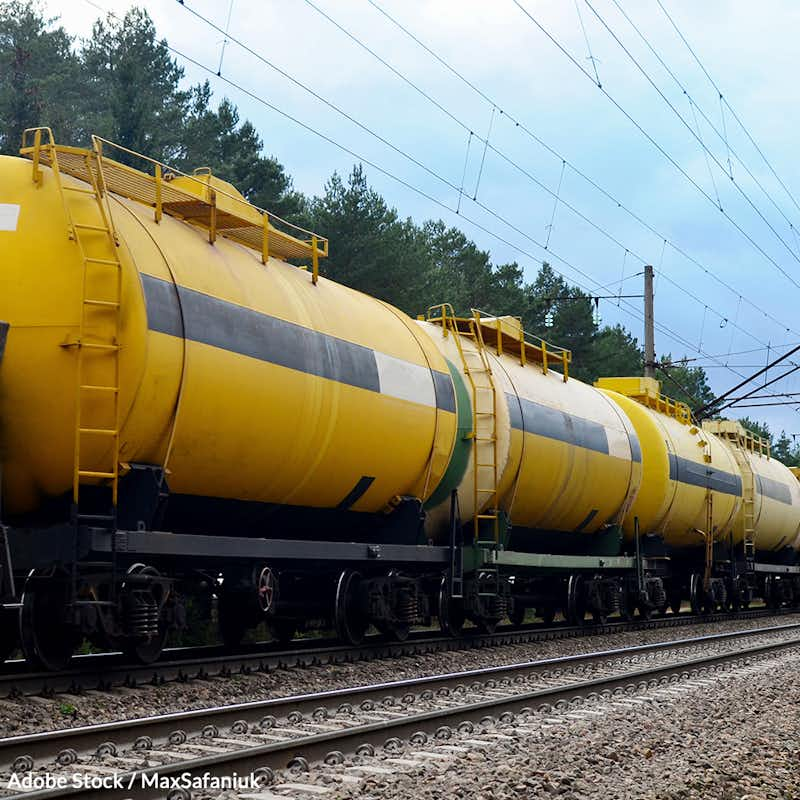Explosive Cargo Puts Our Communities At Risk
1,078 signatures toward our 50,000 Goal
Sponsor: The Rainforest Site
Highly explosive supercooled liquid gas is putting our communities and environment in great danger.

Americans shouldn't have to worry about their families or the environment every time they hear a train whistle blow, but recent changes to the the Hazardous Materials Regulations (HMR) are putting our communities and natural resources at risk.
The Pipeline and Hazardous Materials Safety Administration (PHMSA) has loosened regulations in the the HMR to allow for the bulk transport of "Methane, refrigerated liquid," commonly known as liquefied natural gas (LNG), in rail tank cars1.
These rail tank cars carry LNG at temperatures below -260 degrees Fahrenheit, with no special protections against rupture if a train derails2.
When LNG is exposed to air it turns back into a highly-flammable gas. In a collision, LNG can easily erupt into an unquenchable fire3. Detonating just 22 tank cars of LNG could produce the equivalent energy of the Hiroshima bomb4. A 1944 explosion in Cleveland killed more than 100 people after LNG from a storage tank seeped into the city's sewer system and ignited, leveling homes and businesses across several city blocks3.
In March 2019, a train moving propane in Utah derailed and leaked toxic products into the environment. Responders detonated the derailed cars in place2. No humans were at risk of injury because the train was in a rural area, but the new regulations mean many LNG trains will be going through urban and suburban areas.
LNG is being shipped by rail in pilot programs in Alaska and Florida under Federal Railroad Administration permits, but technical and safety information on these programs has been withheld from the public5. The routes used for LNG by rail in Florida traverse highly populated coastal areas, crossing highways and sharing routes with high-speed passenger trains.
The Department of Transportation's own Emergency Response Guidebook, which is used universally by North American fire and emergency services, advises that in the event of a breached refrigerated liquids transportation container, first responders should immediately isolate the scene for one mile in all directions. This would not be possible in any timely manner within a densely populated area5.
The PHMSA's assessment also ignores any greenhouse gas emission and environmental impacts required by the National Environmental Policy Act (NEPA). The organization did not even request data from the permit applicant on how much greenhouse gas would be emitted if the permit were granted.
Transporting highly flammable liquefied natural gas by rail puts our families and natural resources at too great a risk. Sign the petition below and demand the PHMSA and DOT ban this practice!
More on the issue:
- Pipeline and Hazardous Materials Safety Administration, Federal Register 24 July 2020), "Hazardous Materials: Liquefied Natural Gas by Rail."
- Environmental and Energy Study Institute (19 December 2019), "Trump Administration Loosening Regulations for Rail Transportation of Flammable Natural Gas."
- Jennifer A. Dlouhy, Bloomberg (11 April 2019), "'Bomb Trains.' Trump's Plan to Ship Natural Gas by Rail Raises Alarm."
- Tessa Stuart, Rolling Stone (20 August 2020), "New Trump Rule Could Create 'Bomb Trains,' Environmentalists Say."
- Pipeline and Hazardous Materials Safety Administration, Regulations.gov (6 June 2019), "Hazardous Materials Safety: Notice of Availability of the Draft Environmental Assessment for a Special Permit Request for Liquefied Natural Gas by Rail."
- United States Department of Transportation and Pipeline and Hazardous Materials Safety Administration (18 August 2020) "Emergency Response Guidebook (ERG)."
- Earthjustice (18 August 2020), "What You Should Know About Liquefied Natural Gas and Rail Cars."
The Petition:
To the Secretary of Transportation and Administrator of the Pipeline and Hazardous Materials Safety Administration,
Recent changes to the the Hazardous Materials Regulations (HMR) are putting our communities and environment at great risk. The Pipeline and Hazardous Materials Safety Administration (PHMSA), with the Federal Railroad Administration (FRA), has loosened regulations in the the HMR to allow for the bulk transport of liquefied natural gas (LNG), in rail tank cars.
This rule change is allowing bombs to roll through densely populated American cities, and that's no exaggeration. Detonating just 22 tank cars of LNG could produce the equivalent energy of the Hiroshima bomb. In 1944 explosion in Cleveland killed more than 100 people after LNG from a storage tank seeped into the city's sewer system and ignited, leveling homes and businesses across several city blocks.
The Department of Transportation's own Emergency Response Guidebook, requires that first responders immediately isolate the scene for one mile in all directions when refrigerated LNG containers are breached. This is nearly impossible to do in a timely manner in densely populated areas.
LNG is already being shipped by rail in pilot programs in Alaska and Florida under Federal Railroad Administration permits. The routes used for LNG by rail in Florida traverse highly populated coastal areas, crossing highways and sharing routes with high-speed passenger trains.
This practice is putting our families and natural resources at too great a risk to support an industry many Americans are in favor of moving away from. I demand you reestablish regulations to prohibit the transportation of liquid natural gas by rail.
Sincerely,